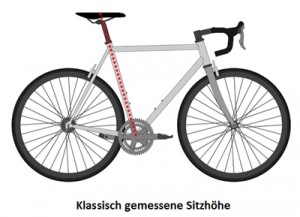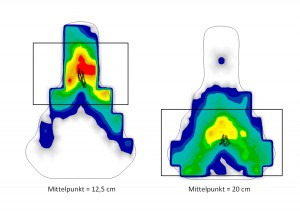Saddle height – an underestimated parameter?
Today, I would like to treat a topic that might seem trivial at first sight: adjusting the correct saddle height. Trivial as many smart scientists have treated this topic before and as there are plenty of formulas (such as LeMond 1990, Gressmann 1990 and others) allowing one to calculate the matching saddle height from one’s inseam.
Why do we need a 2014 blog entry on this well-known topic?
Let me begin with discussing the importance of the parameter saddle height for the entire position on the bike. The wrong adjustment of the saddle height is a main reason for countless troubles, most commonly:
1. Saddle discomfort
A saddle that is adjusted too high often causes saddle discomfort. Already slight changes can have a big impact. In our laboratory we regularly see that reducing the saddle height by 5mm can reduce the maximum pressure on the saddle by 15-20%!
2. Knee problems
Sitting too low can strain the knee especially in the patella area, as the compacting pressure in the pushing phase is increased. Contrary, sitting too high can also over-strain the knee joint.
3. Aches in the lumbar spine
A wrong saddle height makes left-right movements of the hip more likely, thus straining the spinal discs in the lumbar region.
4. Hamstrings
Especially if the hamstrings are shortened a too high saddle can cause muscular tension and even cramps.
A point that has received little attention in the literature is the difference between the measured and the effective saddle height: The saddle height is defined as the distance from bottom bracket to the saddle surface, mostly measured along the seat tube.
In this way many analyses disregard the pressure distribution on the saddle. It is decisive whether the rider predominantly sits on the saddle nose or in the back of the saddle. Accordingly, the measured saddle height can differ from the effective saddle height – sometimes substantially.
An example:
Riders A and B both have the same inseam, and their saddles’ setback is adjusted at 6cm. At a saddle height of 80cm (measured along the seat tube), rider A sits in an area of 10-15cm (average of 12.5cm) behind the saddle nose. His effective saddle height is thus 79.5cm. At the same measured saddle height, rider B sits in the area of 16-24cm (average 20cm) behind the saddle nose. The effective saddle height is 80.5cm. Even though the measured saddle height is the same, the different seating positions on the saddle cause a difference of 1cm in the effective saddle height when comparing riders A and B.
That is why in every bike fitting we not only use the saddle pressure mapping to optimize the saddle but also to adjust the correct saddle height. The parameter ‘center of pressure’ gives us the rider’s central pressure point (e.g. 12.5cm for rider A). In this way the effective saddle height can be considered in evaluating the position.
To conclude, I would like to reflect on the standard saddle height formulas:
In my opinion, formulas can only present an estimate as they result from statistically analysing many subjects and thus represent the average of that sample. However, every individual can deviate more or less from this average. As we know that already minimal changes in the saddle height have an effect on the comfort and the force transmission, it becomes clear that individually adjusting the saddle height should be preferred over sticking to a formula. Individual parameter such as flexibility, shortenings and asymmetries – to name just a few – are not considered in the available formulas. From our lab we know that deviations from the average are rather the rule than the exception – no rider is identical to the other.
Conclusion:
I hope this article serves to emphasise that the saddle height remains a very important bikefitting parameter, that is not yet exhaustively researched. The saddle height has various effects and accordingly it can also influence the contact points foot-pedal and hand-handlebar. A sensible extension to the visual analysis of the foot-knee-hip chain can be using pressure mapping in fitting. This article focuses on saddle height and the problems resulting from a wrong adjustment whereas I will focus on saddle height and force transmission in an upcoming second part.
Author: Daniel Schade
Sources:
LeMond & Gordis: Greg LeMonds Complete Book of Bicycling – 1990.
Gressmann: Fahrradphysik und Biomechanik – 1990.




